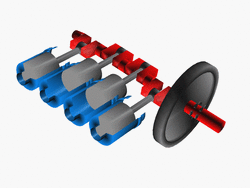
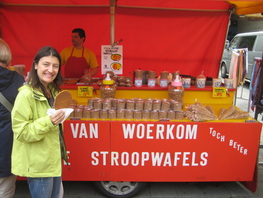
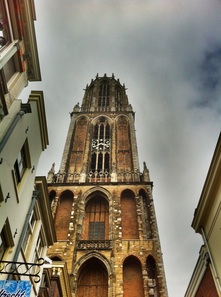
Windmills have been a part of Dutch life for around 1,000 years. A low-lying country rich in rippling winds, it makes sense that the windmill would thrive in the Netherlands. Prior to 1594, however, windmills had limited applications. This is because the circular motion of the windmill would translate only into circular movements of the corresponding gears – useful for milling and irrigation, but not for much else. But one man would change the face of windmills forever and in doing so, would launch an empire.  Crankshaft Cornelis Corneliszoon van Uitgees is described in the sparse texts we have about him as a simple farmer trying to support his family. But he had an idea. Corneliszoon reasoned that if you combined a simple crankshaft (pictured right) with the windmill’s engineering, you could convert the circular movements of the windmill into the back and forth motion needed to power a saw. In 1594, he built his first saw mill and immediately he could cut the same amount of wood in one day as it would take 50 men to cut in that same amount of time.  Another Dutch invention - stroopwaffles! This one innovation launched a huge construction boom at the shipbuilding yards as the Dutch suddenly had more processed wood than any other culture in the world. They constructed thousands of ships over the next 150 years and dominated global commerce as their empire spread across the globe. Who would have known that such a major change in the world could come from a seemingly small improvement to the windmill? It’s particular interesting to note that Corneliszoon didn’t invent either the windmill or the crankshaft. Like many inventors, he didn’t produce something entirely new so much as realize that two existing things could be combined to DO something entirely new. Neda and I have been interested in the delicate circumstances that must exist for someone to make a breakthrough of this type. For instance, all the technology needed to produce a steam engine existed during the Roman Empire, though the first workable steam engine wasn’t produced until the early 18th century. It took thousands of years until Thomas Newcomen figured out how to combine the technology in a way that worked. For us inspiration lies within the possibilities these stories suggest. What materials and ideas can be combined in our day and age to produce changes we never thought possible? From a spiritual perspective, does the key to your happiness not lie in something outside of yourself, but in just effectively combining the many tools you already have? It was these questions and more that journeyed with us as we explored the wonderful country of the Netherlands. We started with an anniversary weekend in Soest, a small town that houses the Soestdijk Palace as well as a working windmill. Our visit to the windmill and discussion with the millman there prompted the post above. We also went sailing with our CS host Max in the beautiful inlet to the North Sea created by the Zuiderzee Works, an engineering marvel by which the Dutch created "new land" in the early 20th century.  The Dom Tower before a rain From Soest, we traveled to Utrecht, a university town in the center of the Netherlands. For me it was a reunion of sorts, as this year marks the 10th sine I studied abroad at Utrecht University with several close friends from college. Though none of them could make it to Utrecht at the same time, we visited many of our old haunts (Café Belgie, the “Culture” Boat, ACU, the Dom tower, and of course, Mr. Jack’s). We also biked along the Oudegracht canal to Castle Zuylen, passing the canalboat red light district along the way. Special thanks to Catherine, our CS host for her company, restaurant recommendations, and for teaching us how to make homemade paneer! Utrecht led to our last city of the tour, Amsterdam. The cultural capital of the Netherlands is teeming with life. We met up with our traveling buddy Shea to explore the rambunctious streets of the canal lined city. Visits to the Van Gogh Museum and Anne Frank house were interspersed with delicious beers at Brouwerij’t IJ with our CS host Eran as well as visits to coffeeshops like De Dampkring, where Brad Pitt and George Clooney filmed Ocean’s 12. Old Memories mixed with new on this part of the trip, and just like Corneliszoon’s windmill, who knows what the new combination will create inside of us? For now we’ll have to wait and see as we prepare to jump across the channel and stage our own British Invasion! See pics of Soest and Utrecht here: http://flic.kr/s/aHsjAboB45 and pics of Amsterdam here: http://flic.kr/s/aHsjAbqUGd.
0 Comments
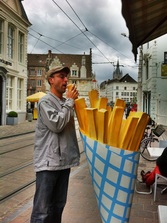 Ahhh Belgium – home of sumptuous chocolates, golden “frites” (french fries), and seemingly supersaturated beers! Our first stop in Brussels provided all 3 of these in quantities we could barely handle. Famous chocolatiers lined the streets and we delightfully sampled their wares piece by piece. Fries slathered in mayo and mustard sauces would provide the fuel to move us along to the local pub where the local abbey beers would lift our spirits, sporting typical alcohol percentages of 8-11%! In total, we sampled no less than 40 different Belgian brews in our 5 days here! 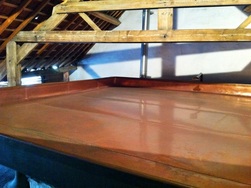 Cooling Tun Of particular fascination for Neda and me was a visit to the family run Cantillon Brewery in Brussels, the last brewery in the world to brew only traditional Lambic beers. Lambics are special because they are inoculated by a broad range of wild airborne fermenting agents in the open cooling tun in which they sit for just one night during the winter months. In that night, the sugary wort that was distilled from boiling wheat, malted barley (and later hops), sits in the cooling tun (pictured right) and attracts all manners of life to grow inside of it. The result is a slightly different beer with each batch. In just one Lambic batch brewed at Cantillon, organic chemists have found over 100 different strains of yeast, 27 strains of acetic acid bacteria, and 38 strains of lactic acid bacteria. By contrast, a typical commercial beer contains only one type of brewer’s yeast, which is added manually instead of by nature. This leads to a uniformity of taste and to limited health benefits (as we’ll see later). To top it off, nearly every beer in the world is pasteurized after production (to extend shelf life) thereby killing whatever live bacteria initially fermented it. 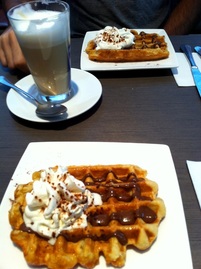 Belgium Waffles! While it might seem strange to seek out this “live beer” filled with bacteria and yeast, it is actually a tradition as old as time, and for good reason. Prior to modern brewing methods all beer was naturally fermented and the live organisms produced anaerobic (no air) environments inside the barrels that allowed the beer to stay preserved for years. But it's not just live beer that interests us – it's live food in general. Neda has been working on perfecting her sourdough bread recipe with wild bacteria. In this process, she mixes flour and water and catches live yeast from the fresh Bulgarian air by means of a temperature controlled “yeast catcher” her Dad made for us. Meanwhile, I made a mean batch of low salt sauerkraut that stays good for months not through the preservative of salt, but through the protection of the billions of probiotic bacteria living inside the jar. Nearly every culture has developed processes for creating live food, though their popularity has diminished in recent times. Neda and I are interested in studying the various forms and reintroducing them into our culture. Why you ask? Simply put, live foods support our health from the inside out. A fleet of about 100 trillion microorganisms called by scientists the “microbiome” support our health in a variety of ways. In fact, there are 10x more microbial cells in our body than cells containing human DNA, making the question of our identity a little tricky. Are we just the packaging for their lives? All these organisms work together (there are over 1000 different species and counting that have been identified in the microbiome) to synthesize the essential proteins and vitamins our body needs to survive. These “probiotics” (bacteria supporting our health) also combat the growth of bacteriods, harmful bacteria that produce ammonia and promote the growth of unhealthy fungi and yeasts in our gut. Essentially, live foods offering probiotics support our immune system, digestion, and a huge variety of other bodily functions. In this way, the beer at Cantillon could be considered the healthiest in the world because it packs a wallop of probiotics and the b-vitamins that they produce in each sip. We weren’t just literally "living it up" with probiotics in Belgium. We countered any health we acquired with live beer with an endless stream of non-live beers (essentially all beers other than Cantillon), beef stews, fries, and of course those perfectly refined chocolates! 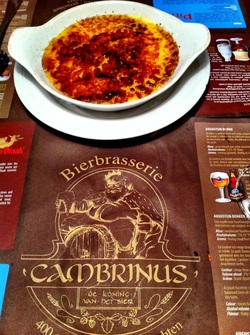 In between the decadence, we visited the famous Atomium (pictured above) - a sculpture of an iron crystal magnified 165 billion times and built for the 1958 World’s Fair. We learned about the dream for a unified Europe that arose out of WWII at the EU Parliament and we met many friends through couchsurfing. A special thanks to Maja for her hospitality, and to Annie, Collin, Ben and Christin for the homecooked dinner and homebrews! After Brussels, we headed to Gent, an ancient city highlighted by its magnificent skyline comprised of two churches and belfry. Our CS host Yola treated us like family as she took us on a tour of the city, its beers, its history, and its food! Finally, we ended our trip in Brugges, the romantic medieval city. The highlight for us there was a meal at Gambrinus restaurant (the legendary king of beer, said to have brewed the first lambic beers as described above), which served us Trappist cheese croquettes, beer braised rabbit, Flemish Carbonades prepared with “Gulden Draak” Beer, and Crème Brûlée perfumed with the dark Abbey beer Ename (pictured to the right). Now it’s our first day in the Netherlands in a little village called Soest. We are staying with some CS hosts who left us their home for the day because they had to work on their boat. They made us a little anniversary breakfast (it’s our 4 year anniversary today!) and now are enjoying some time together before moving on to Utrecht and Amsterdam! See all the pics of our great time in Belgium here: http://flic.kr/s/aHsjzZwKDE
|